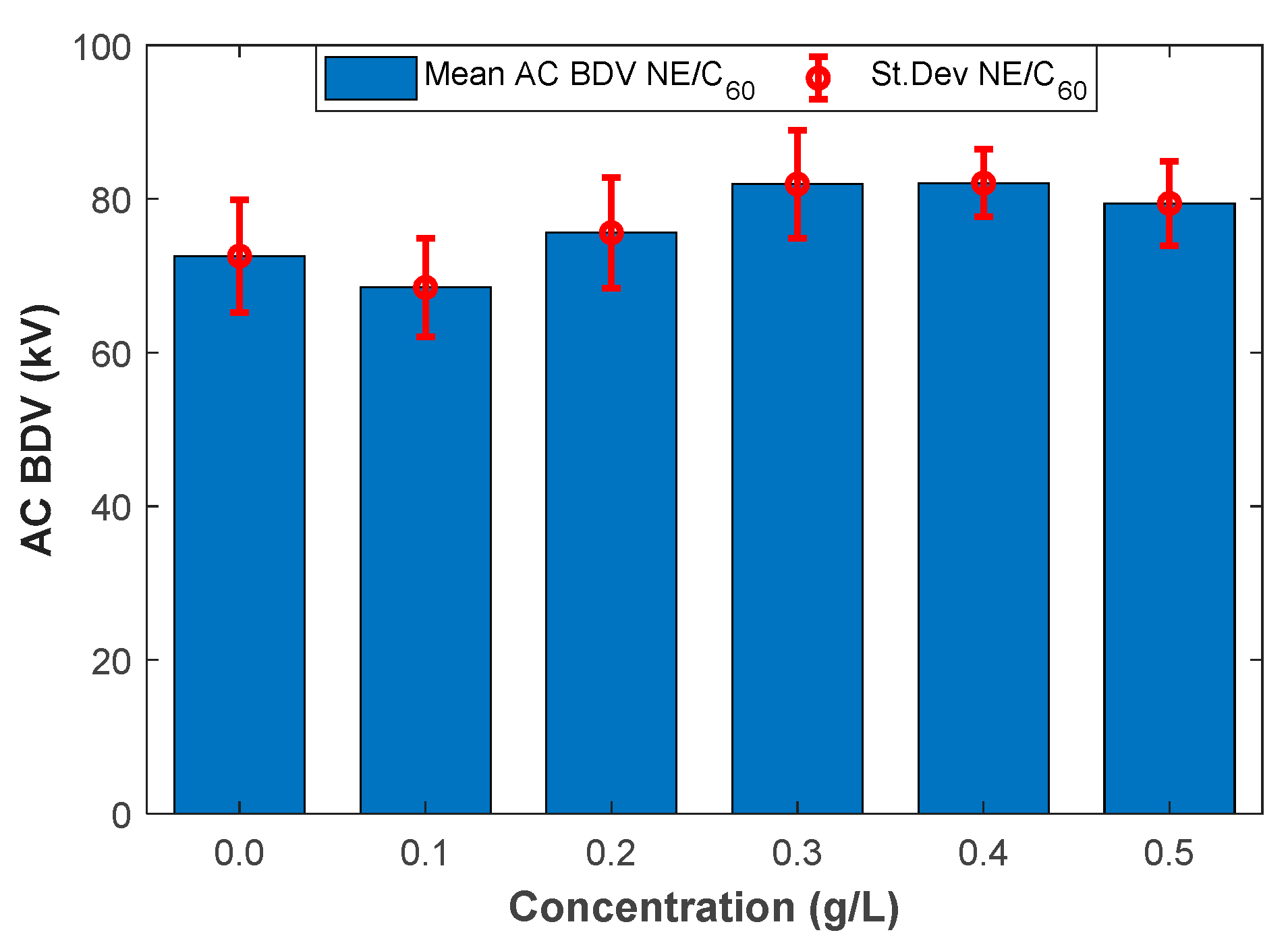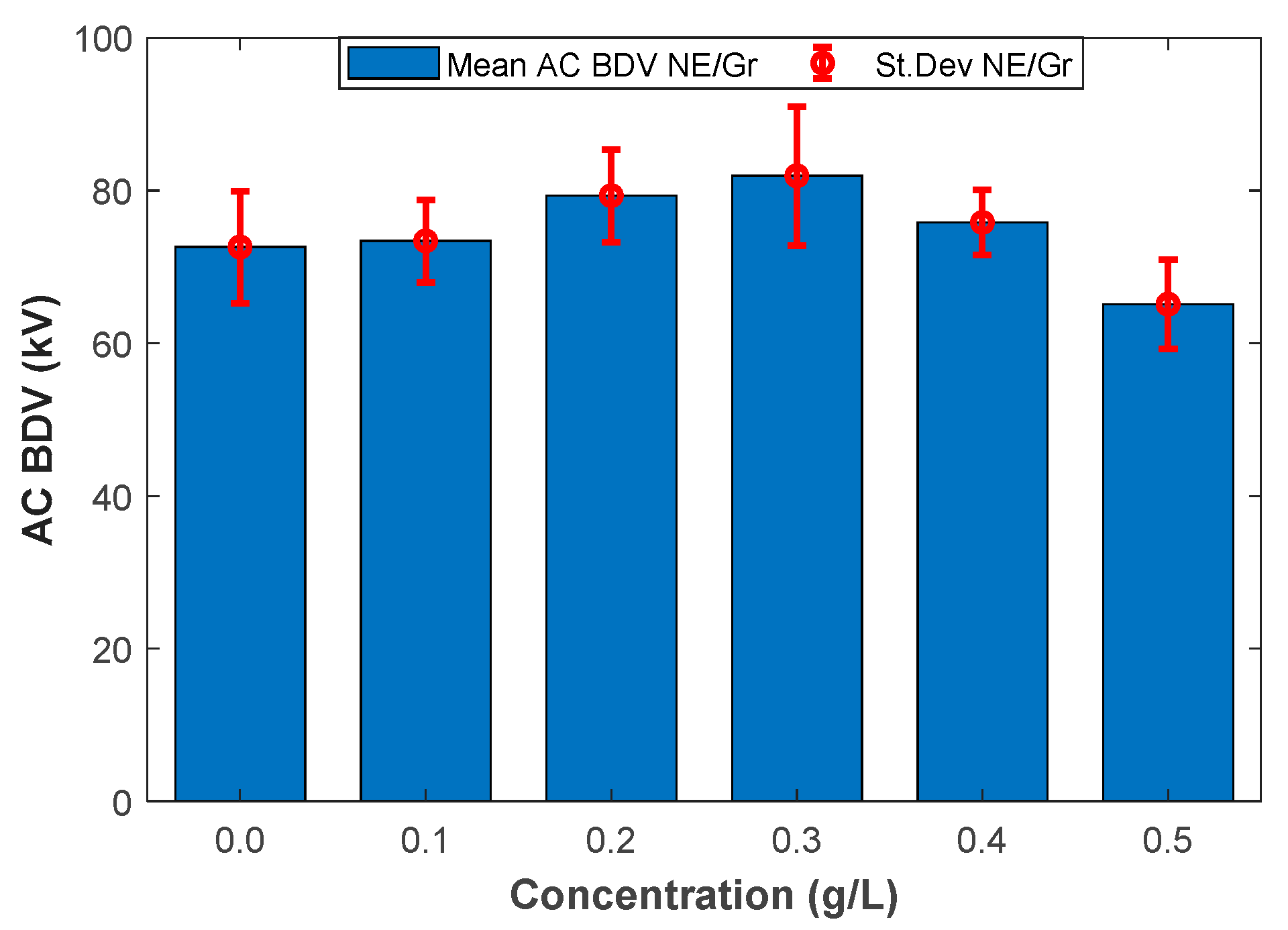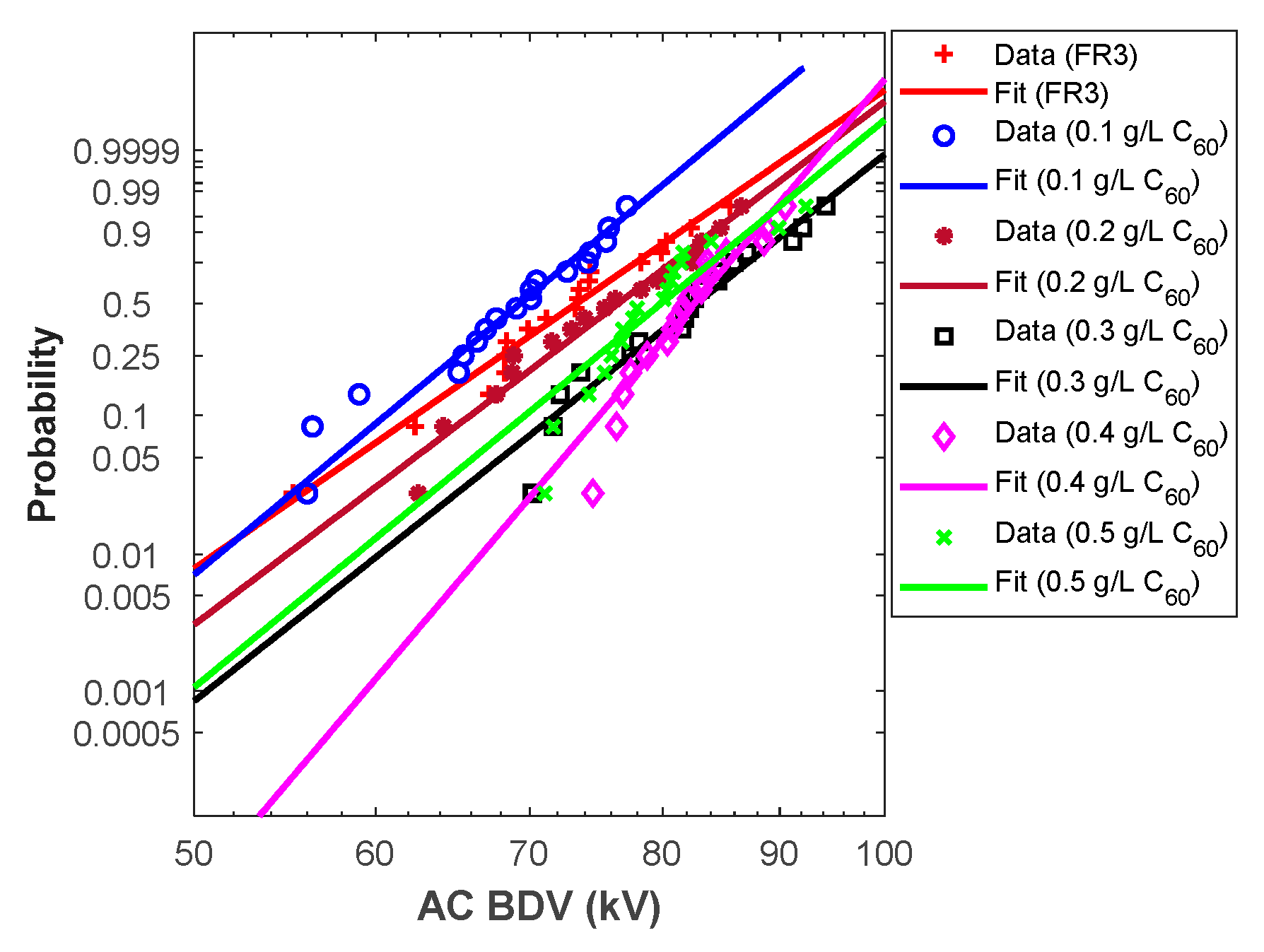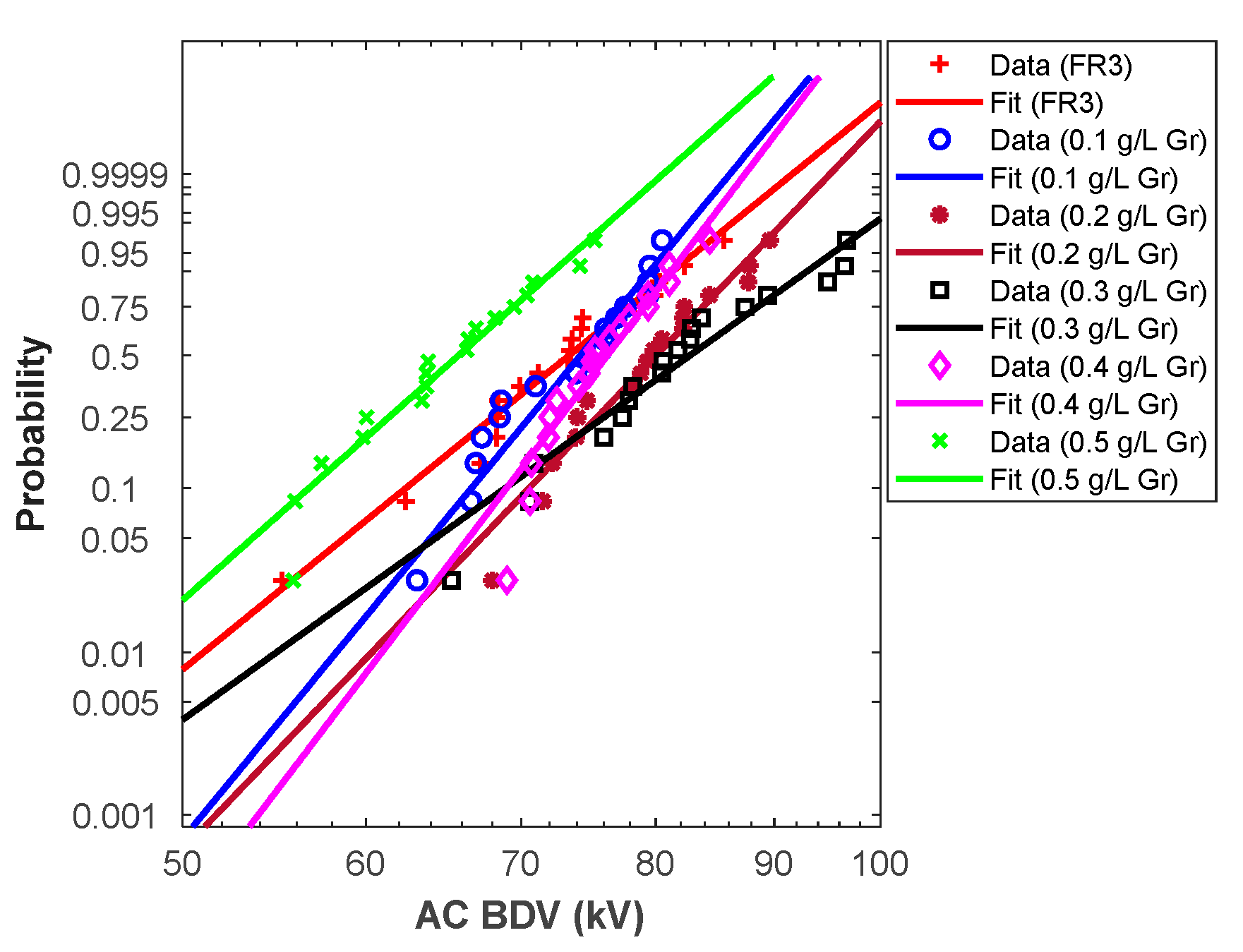Effect of Fullerene and Graphene Nanoparticles on the AC Dielectric Strength of Natural Ester
Abstract
1. Introduction
2. Materials and Methods
2.1. Materials
2.2. Preparation of Nanofluids
2.3. AC Breakdown Measurement
3. Results and Discussion
3.1. Statistical t-Test
3.2. AC Breakdown Voltage
3.3. Weibull Statistical Analysis
4. Conclusions
- The t-test showed a significant evident difference in mean AC BdV in the case of natural ester and the different investigated NFs.
- The AC BdV of FR3 increased when adding the C60 and Gr NPs with specified doping concentrations. However, the C60 NFs showed the best improvement of the AC BdV with a 13.08% improvement with 0.4 g/L compared to FR3, while Gr NFs showed the best improvement, i.e., 12.79%, with 0.3 g/L.
- 0.1 g/L C60 NF and 0.5 g/L Gr NF harm natural ester’s mean AC BdV.
- The statistical analysis showed that all the AC BdV outcomes obey the Weibull distribution (except 0.5 g/L C60 NF). So, the fit curves were then used to evaluate the BdVs at different risk levels (1%, 10%, and 50%).
Author Contributions
Funding
Data Availability Statement
Conflicts of Interest
Appendix A. Two-Sample t-Test
- The calculation of the t-value (two-sample t-test, called the Welch t-test) is given by the formula below [28]:where and are the mean values of set 1 and 2, respectively, Δ is the hypothesized difference (0 for equal and 1 for unequal means), s1 and s2 are the standard deviations of set 1 and 2, respectively, and n1 and n2 are the sizes of set 1 and 2, respectively.
- The df value is then used to determine the critical values from the t-value table. Because this is a one-tailed test, the alpha level is 0.05.
- The following step consists of looking up t1−α, df (α = 0.05, 1 − α = 0.95, df) value in the t-table [28], and looking for the critical value, which corresponds to the limit t-value for a known degree of freedom.
- If t-value >= t 1-alpha, df, the null hypothesis cannot be rejected in this case, and the two data sets appear different.
- If t-value < t 1-alpha, df, the null hypothesis is rejected in this case, and the two data sets do not appear different.
Appendix B. Anderson–Darling Fitting Test
References
- Fofana, I. 50 Years in the Development of Insulating Liquids. IEEE Electr. Insul. Mag. 2013, 29, 13–25. [Google Scholar] [CrossRef]
- Krawiec, S. Review of Recent Changes to Mineral Insulating Oil Specifications. In Proceedings of the 2009 IEEE Electrical Insulation Conference, Virginia Beach, VA, USA, 18–21 October 2009; pp. 363–367. [Google Scholar]
- Lyutikova, M.N.; Korobeynikov, S.M.; Rao, U.M.; Fofana, I. Mixed Insulating Liquids with Mineral Oil for High-Voltage Transformer Applications: A Review. IEEE Trans. Dielectr. Electr. Insul. 2022, 29, 454–461. [Google Scholar] [CrossRef]
- Azli, S.A.; Hezri Fazalul Rahiman, M.; Yusoff, Z.M.; Fadzilah Razali, N.; Abd Wahid, S.S.; Sufian Ramli, M. A Review on Alternative Oils as Dielectric Insulating Fluids on Power Transformer. In Proceedings of the 2019 IEEE 15th International Colloquium on Signal Processing & Its Applications (CSPA), Pulau Pinang, Malaysia, 8–9 March 2019; pp. 198–201. [Google Scholar]
- Mehta, D.M.; Kundu, P.; Chowdhury, A.; Lakhiani, V.K.; Jhala, A.S. A Review on Critical Evaluation of Natural Ester Vis-a-Vis Mineral Oil Insulating Liquid for Use in Transformers: Part 1. IEEE Trans. Dielectr. Electr. Insul. 2016, 23, 873–880. [Google Scholar] [CrossRef]
- Oommen, T.V. Vegetable Oils for Liquid-Filled Transformers. IEEE Electr. Insul. Mag. 2002, 18, 6–11. [Google Scholar] [CrossRef]
- Claiborne, C.C.; Pearce, H.A. Transformer Fluids. IEEE Electr. Insul. Mag. 1989, 5, 16–19. [Google Scholar] [CrossRef]
- Rao, U.M.; Fofana, I.; Beroual, A.; Rozga, P.; Pompili, M.; Calcara, L.; Rapp, K.J. A Review on Pre-Breakdown Phenomena in Ester Fluids: Prepared by the International Study Group of IEEE DEIS Liquid Dielectrics Technical Committee. IEEE Trans. Dielectr. Electr. Insul. 2020, 27, 1546–1560. [Google Scholar] [CrossRef]
- Cargill Envirotemp FR3 Fluid; Formulated for Performance 2018; Cargill: Minneapolis, MN, USA, 2018.
- Yu, W.; Xie, H. A Review on Nanofluids: Preparation, Stability Mechanisms, and Applications. J. Nanomater. 2012, 2012, 1–17. [Google Scholar] [CrossRef]
- Sidik, N.A.C.; Mohammed, H.A.; Alawi, O.A.; Samion, S. A Review on Preparation Methods and Challenges of Nanofluids. Int. Commun. Heat Mass Transf. 2014, 54, 115–125. [Google Scholar] [CrossRef]
- Huang, Z.; Li, J.; Yao, W.; Wang, F.; Wan, F.; Tan, Y.; Mehmood, M.A. Electrical and Thermal Properties of Insulating Oil-based Nanofluids: A Comprehensive Overview. IET Nanodielectrics 2019, 2, 27–40. [Google Scholar] [CrossRef]
- Ahmad, F. State-of-Art in Nano-Based Dielectric Oil: A Review. IEEE Access 2019, 7, 15. [Google Scholar] [CrossRef]
- Choi, S.U.; Eastman, J.A. Enhancing Thermal Conductivity of Fluids with Nanoparticles; Argonne National Lab.: Lemont, IL, USA, 1995. [Google Scholar]
- Hwang, J.G.; Zahn, M.; O’Sullivan, F.M.; Pettersson, L.A.A.; Hjortstam, O.; Liu, R. Effects of Nanoparticle Charging on Streamer Development in Transformer Oil-Based Nanofluids. J. Appl. Phys. 2010, 107, 14310. [Google Scholar] [CrossRef]
- Chen, J.; Sun, P.; Sima, W.; Shao, Q.; Ye, L.; Li, C. A Promising Nano-Insulating-Oil for Industrial Application: Electrical Properties and Modification Mechanism. Nanomaterials 2019, 9, 788. [Google Scholar] [CrossRef] [PubMed]
- Segal, V.; Rabinovich, A.; Nattrass, D.; Raj, K.; Nunes, A. Experimental Study of Magnetic Colloidal Fluids Behavior in Power Transformers. J. Magn. Magn. Mater. 2000, 215–216, 3. [Google Scholar] [CrossRef]
- Duzkaya, H.; Beroual, A. Statistical Analysis of AC Dielectric Strength of Natural Ester-Based ZnO Nanofluids. Energies 2020, 14, 99. [Google Scholar] [CrossRef]
- Beroual, A.; Duzkaya, H. AC and Lightning Impulse Breakdown Voltages of Natural Ester Based Fullerene Nanofluids. IEEE Trans. Dielect. Electr. Insul. 2021, 28, 1996–2003. [Google Scholar] [CrossRef]
- Khelifa, H.; Vagnon, E.; Beroual, A. AC Breakdown Voltage and Partial Discharge Activity in Synthetic Ester—Based Fullerene and Graphene Nanofluids. IEEE Access 2022, 10, 5620–5634. [Google Scholar] [CrossRef]
- Khelifa, H.; Beroual, A.; Vagnon, E. Effect of Conducting, Semi-Conducting and Insulating Nanoparticles on AC Breakdown Voltage and Partial Discharge Activity of Synthetic Ester: A Statistical Analysis. Nanomaterials 2022, 12, 2105. [Google Scholar] [CrossRef]
- D’Agostino, R. Goodness-of-Fit-Techniques; Routledge: England, UK, 2017. [Google Scholar]
- Marsaglia, G.; Marsaglia, J. Evaluating the Anderson-Darling Distribution. J. Stat. Soft. 2004, 9, 1–5. [Google Scholar] [CrossRef]
- Anderson, T.W.; Darling, D.A. Asymptotic Theory of Certain “Goodness of Fit” Criteria Based on Stochastic Processes. Ann. Math. Stat. 1952, 23, 193–212. [Google Scholar] [CrossRef]
- Sima, W.; Shi, J.; Yang, Q.; Huang, S.; Cao, X. Effects of Conductivity and Permittivity of Nanoparticle on Transformer Oil Insulation Performance: Experiment and Theory. IEEE Trans. Dielect. Electr. Insul. 2015, 22, 380–390. [Google Scholar] [CrossRef]
- Morgan, H.; Green, N.G. AC Electrokinetics: Colloids and Nanoparticles; Microtechnologies and microsystems series; Research Studies Press: England, UK, 2003; ISBN 978-0-86380-255-3. [Google Scholar]
- Fasehullah, M.; Wang, F.; Jamil, S.; Bhutta, M.S. Influence of Emerging Semiconductive Nanoparticles on AC Dielectric Strength of Synthetic Ester Midel-7131 Insulating Oil. Materials 2022, 15, 4689. [Google Scholar] [CrossRef] [PubMed]
- Boslaugh, S.; Watters, P.A. Statistics in a Nutshell: A Desktop Quick Reference; O’Reilly Media, Inc.: Sebastopol, CA, USA, 2012. [Google Scholar]
- Ferris, C.D.; Grubbs, F.E.; Weaver, C.L. Operating Characteristics for the Common Statistical Tests of Significance. Ann. Math. Stat. 1946, 17, 178–197. [Google Scholar]




| Property | Unit | FR3 | |
|---|---|---|---|
| Density at 20 °C | kg/L | 0.92 | |
| Kinematic Viscosity | mm2/s | ||
| at | 40 °C | 32–34 | |
| at | 0 °C | 190 | |
| Pour point | °C | (−23)–(−18) | |
| Flash point | °C | 255 | |
| Fire point | °C | 350–360 | |
| Water content | ppm | 4–50 | |
| AC BdV | kV | 73 | |
| Power Factor at 90 °C | – | <0.02 | |
| NPs | Fullerene (C60) | Graphene (Gr) |
|---|---|---|
| Diameter (nm) | 4–8 | 20 |
| Specific surface area (m2/g) | – | 40 |
| Density (g/cm3) | 3.4 | 5.1 |
| Purity (%) | 99.5 | 99.5 |
| FR3/NFs with Fullerene | |||||
| 0.1 g/L | 0.2 g/L | 0.3 g/L | 0.4 g/L | 0.5 g/L | |
| t-value | −1.7811 | 1.243 | 3.9044 | 4.7093 | 3.1653 |
| Degree of freedom (df) | 92.7 | 94.4 | 94.2 | 77.2 | 87.5 |
| Critical value | >1.6619 | <1.6617 | >1.6617 | >1.6654 | >1.6628 |
| Decision | different | indifferent | different | different | different |
| FR3/NFs with Graphene | |||||
| 0.1 g/L | 0.2 g/L | 0.3 g/L | 0.4 g/L | 0.5 g/L | |
| t-value | 0.4033 | 2.9940 | 3.4452 | 1.5726 | −3.3938 |
| Degree of freedom (df) | 86.7 | 91.0821 | 91.6358 | 75.6653 | 89.7669 |
| Critical value | <1.6631 | >1.6623 | >1.6621 | <1.6657 | >1.6625 |
| Decision | indifferent | different | different | indifferent | different |
| Concentration | FR3 | Fullerene (C60) | Graphene (Gr) | |
|---|---|---|---|---|
| 0.1 (g/L) | BdV (kV) | 72.58 | 68.49 | 73.4 |
| St. Dev (kV) | 7.34 | 6.40 | 5.40 | |
| Increment % | – | −5.63 | +1.17 | |
| 0.2 (g/L) | BdV (kV) | 72.58 | 75.59 | 79.3 |
| St. Dev (kV) | 7.34 | 7.21 | 6.03 | |
| Increment % | – | +4.15 | +9.25 | |
| 0.3 (g/L) | BdV (kV) | 72.58 | 81.94 | 81.9 |
| St. Dev (kV) | 7.34 | 7.04 | 9.09 | |
| Increment % | – | +12.89 | +12.79 | |
| 0.4 (g/L) | BdV (kV) | 72.58 | 82.08 | 75.8 |
| St. Dev (kV) | 7.34 | 4.39 | 4.24 | |
| Increment % | – | +13.08 | +4.39 | |
| 0.5 (g/L) | BdV (kV) | 72.58 | 79.42 | 65.10 |
| St. Dev (kV) | 7.34 | 5.50 | 5.82 | |
| Increment % | – | +9.43 | −10.35 |
| Concentration (g/L) | p-Value | Decision |
|---|---|---|
| FR3 | 0.63 | Accepted |
| FR3/Fullerene (C60) NFs | ||
| 0.1 | 0.66 | Accepted |
| 0.2 | 0.81 | Accepted |
| 0.3 | 0.60 | Accepted |
| 0.4 | 0.21 | Accepted |
| 0.5 | 0.01< | Rejected |
| FR3/Graphene (Gr) NFs | ||
| 0.1 | 0.15 | Accepted |
| 0.2 | 0.61 | Accepted |
| 0.3 | 0.20 | Accepted |
| 0.4 | 0.45 | Accepted |
| 0.5 | 0.75 | Accepted |
| Concentration (g/L) | α (Scale) | β (Shape) |
|---|---|---|
| FR3 | 75.7 | 21.50 |
| FR3/Fullerene (C60) NFs | ||
| 0.1 | 71.19 | 13.98 |
| 0.2 | 75.62 | 12.73 |
| 0.3 | 85.07 | 13.30 |
| 0.4 | 84.15 | 19.80 |
| 0.5 | 82.05 | 13.81 |
| FR3/Fullerene (Gr) NFs | ||
| 0.1 | 73.81 | 17.43 |
| 0.2 | 82.01 | 14.97 |
| 0.3 | 85.74 | 10.29 |
| 0.4 | 77.72 | 18.88 |
| 0.5 | 67.68 | 12.71 |
| 1% | 10% | 50% | ||||
|---|---|---|---|---|---|---|
| AC BdV (kV) | Increment (%) | AC BdV (kV) | Increment (%) | AC BdV (kV) | Increment (%) | |
| FR3 | 51.1 | – | 62.5 | – | 73.4 | – |
| FR3/Fullerene (C60) NFs | ||||||
| (0.1 g/L) | 51.3 | 0.39 | 60.7 | −2.88 | 69.4 | −5.45 |
| (0.2 g/L) | 54.9 | 7.44 | 66.0 | 5.60 | 76.6 | 4.36 |
| (0.3 g/L) | 60.2 | 17.81 | 71.9 | 15.04 | 82.8 | 12.81 |
| (0.4 g/L) | 66.7 | 30.53 | 75.2 | 20.32 | 82.7 | 12.67 |
| (0.5 g/L) | 58.8 | 15.07 | 69.8 | 11.68 | 80.0 | 8.99 |
| FR3/Fullerene (Gr) NFs | ||||||
| (0.1 g/L) | 58.3 | 14.09 | 66.7 | 6.72 | 74.3 | 1.23 |
| (0.2 g/L) | 60.3 | 18.00 | 70.6 | 12.96 | 80.1 | 9.13 |
| (0.3 g/L) | 54.9 | 7.44 | 69.0 | 10.4 | 82.8 | 12.81 |
| (0.4 g/L) | 61.0 | 19.37 | 69.0 | 10.4 | 76.3 | 3.95 |
| (0.5 g/L) | 47.2 | −7.63 | 56.8 | −9.12 | 65.9 | −10.22 |
Disclaimer/Publisher’s Note: The statements, opinions and data contained in all publications are solely those of the individual author(s) and contributor(s) and not of MDPI and/or the editor(s). MDPI and/or the editor(s) disclaim responsibility for any injury to people or property resulting from any ideas, methods, instructions or products referred to in the content. |
© 2023 by the authors. Licensee MDPI, Basel, Switzerland. This article is an open access article distributed under the terms and conditions of the Creative Commons Attribution (CC BY) license (https://creativecommons.org/licenses/by/4.0/).
Share and Cite
Khelifa, H.; Vagnon, E.; Beroual, A. Effect of Fullerene and Graphene Nanoparticles on the AC Dielectric Strength of Natural Ester. Energies 2023, 16, 1995. https://doi.org/10.3390/en16041995
Khelifa H, Vagnon E, Beroual A. Effect of Fullerene and Graphene Nanoparticles on the AC Dielectric Strength of Natural Ester. Energies. 2023; 16(4):1995. https://doi.org/10.3390/en16041995
Chicago/Turabian StyleKhelifa, Hocine, Eric Vagnon, and Abderrahmane Beroual. 2023. "Effect of Fullerene and Graphene Nanoparticles on the AC Dielectric Strength of Natural Ester" Energies 16, no. 4: 1995. https://doi.org/10.3390/en16041995
APA StyleKhelifa, H., Vagnon, E., & Beroual, A. (2023). Effect of Fullerene and Graphene Nanoparticles on the AC Dielectric Strength of Natural Ester. Energies, 16(4), 1995. https://doi.org/10.3390/en16041995







